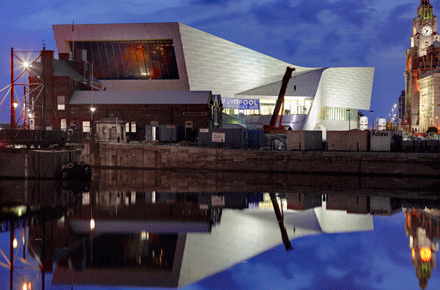Our student panel give their impression on the futuristic waterfront museum by Danish architect 3XD

About the scheme
This is the £70m Liverpool National Museum designed by Danish practice 3XN. The 13,000m2 waterfront building is clad in folded limestone panels and containing exhibits relating to the city’s cultural heritage.
Craig Allen’s verdict
There it is, like a curiously wrapped present on Christmas morning. Indeed, it feels as though the justification for this building was made in a similar fashion to when you are conducting a last minute Christmas shopping spree; lots of stuff on the shelves but nothing quite fitting the bill. The result being a grudging compromise.
When I saw the original design by Studio 3XN it felt less like a bargain. In 2008, the proposal had attitude, optimism and sleekness; the completed form in 2011 (after 3XN’s role was reduced and given over others including Manchester based architects AEW) conveys a dramatically weaker relation to such positive nouns.
Growing up in the North West of England, I have become accustomed to these blocks and shapes popping up in the town centres. I was in my teens when Urbis was completed in Manchester. After grand proclamations were made upon the completion of Ian Simpson’s glass structure, it now remains in the city centre still struggling to fit in like someone who arrives late to a party, and then remains too sober to relax with the revellers. The result is a building that sits awkwardly on the edge of the town centre - and to continue the personified comparison - with nothing to say, and not many people taking much notice. In a nihilistic and somewhat melancholic nod to Morrissey, perhaps the bigger question these buildings start to ask is to whether their existence is necessary at all.
I imagine the Liverpool Museum will join such dialectic. Urbis, when completed, was a museum of the city, housing an exhibition on not just Manchester, but the cities of the world. It has failed. Since 2002, it has housed numerous alternative exhibitions with little success to justify its £30m cost. It is now about to open as the National Football Museum. I hope this time is has more success, not least for the sake of the people of Manchester.
Likewise, I really wish for Liverpool Museum to succeed, for the people of Liverpool. After all, the waterfront is what fills many Liverpudlians with architectural pride – to damage that by debunking the waterfront with mediocre compromise would represent a crushing failure.
Yet it is difficult to subdue a first impression that the Liverpool Museum represents a glaring missed opportunity for the city. It is bold in the jarring relation of scale to its surroundings, in the odd aesthetic of repressed expression, in its gingerly relation to the surroundings; unfortunately it is not seemingly bold in an outright positive manner. It is nice to have something new, like it is nice to get a computer console or exercise bike at Christmas. However, like a good gift shows an understanding of the receiver’s character, a good building shows affinity for the environment onto which it is deposited.
Jessica Taylor-Tibbott’s verdict
The museum is located on Liverpool’s waterfront on a large site which offers lots of exterior space to the public. The exterior form is a sharp contrast to the other buildings that can be seen on the waterfront and it is not immediately obvious it is a museum containing exhibitions centred on the city’s cultural heritage. The interior of the building is very bright with lots of open spaces and organic forms and this is starkly juxtaposed with the building’s angular exterior.
Tom Smith’s verdict
The futuristic Liverpool National Museum designed by 3XN, a Danish practice, works well with the contrasting sharp straight edging and the fluid smooth curve façade of the museum, featuring the characteristics of a smooth rolling wave from the waterfront.
The heritage site contrasts hugely to this ultra-modern museum, the traditional material of limestone helps combine the two genres together with the clad panel twist.
In addition the geometric shape included into the design of the Liverpool National Museum generates interest to the form of the building and the texture of material when the light strikes the façade.
Craig Allen is a recent graduate from the Royal College of Art’s architecture school, and Jessica Taylor-Tibbott and Tom Smith are architecture students at Nottingham Trent University.



























No comments yet